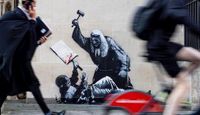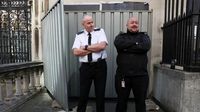On the morning of September 8, 2025, Londoners passing by the Royal Courts of Justice on Carey Street were met with an unexpected sight: a new mural by the elusive street artist Banksy, stenciled boldly on the building’s outer wall. The artwork, which Banksy shared with his 13.3 million Instagram followers that same day, depicts a judge in a traditional white wig and black robes, forcefully striking a protester sprawled on the ground and clutching a blood-splattered placard. The image is arresting, its message unmistakable—a pointed critique of the state’s response to recent protests in support of Palestinian activism.
The mural’s appearance came just two days after nearly 900 people were arrested during a demonstration in Parliament Square, London. The protest, organized by Defend Our Juries, was a response to the UK government’s July 2025 decision to designate the activist group Palestine Action as a terrorist organization, a move that made supporting the group a criminal offense punishable by up to 14 years in prison. According to the Metropolitan Police, a staggering 890 people were arrested on September 6, with 857 detained solely for voicing support for Palestine Action. The remaining 33 arrests were for various infractions, including 17 for assaulting police officers.
Witnesses and rights groups described the protest as overwhelmingly peaceful, with attendees—estimated at around 1,500—holding homemade signs that read, “I oppose genocide. I support Palestine Action.” Yet, the police response was swift and severe. Amnesty International’s director of campaigns and communications, Kerry Mascogiuri, condemned the arrests, calling them “a new low for protest rights in this country.” Mascogiuri stated, “It’s completely ridiculous for police to be targeting and arresting people for sitting down, quietly holding a sign.” She added that Amnesty observers saw “entirely peaceful” crowds, despite some heated exchanges. “Police officers, on a number of occasions, were aggressive towards supporters of the protest. This included violently shoving people away and pulling out batons to make space whilst protesters were arrested and hauled into police vans. Peaceful protest is a fundamental right. The scenes yesterday were a shocking demonstration of how the UK’s overly broad terrorism laws are being used to suppress free speech.”
The context surrounding Banksy’s mural is as charged as the image itself. In June, members of Palestine Action vandalized two military aircraft with red paint and crowbars, leading to the group’s proscription the following month. The Labour government’s decision to ban the group has drawn criticism from civil liberties advocates and human rights organizations, who argue that it criminalizes pro-Palestinian activism and threatens the right to peaceful protest. Amnesty International called the government’s move “a disturbing legal overreach,” and lawyers have warned that it sets a dangerous precedent for restricting activism on foreign policy issues.
Banksy’s choice of location for his mural is no accident. The Royal Courts of Justice is a Grade II listed building, a status that obliges authorities to preserve its original character. Within hours of the mural’s appearance, security officials acted decisively: the artwork was concealed behind black plastic sheets and two metal barricades, guarded by security personnel and monitored by CCTV cameras. The rapid response underscored both the value of Banksy’s art and the controversy it ignites. As reported by the BBC and other outlets, curious bystanders gathered before the mural was hidden from public view, a testament to the powerful draw of Banksy’s work and the urgency of its subject matter.
For many activists and supporters, the mural is more than just a piece of art—it’s a rallying cry. A spokesperson for Defend Our Juries described the work as one that “powerfully depicts the brutality unleashed” on peaceful protesters by the government’s ban. In a statement to Common Dreams, the group said, “When the law is used as a tool to crush civil liberties, it does not extinguish dissent—it strengthens it. As Banksy’s artwork shows, the state can try to strip away our civil liberties, but we are too many in number and our resolve to stand against injustice cannot be beaten—our movement against the ban is unstoppable and growing every day.” They encouraged those moved by the mural to join future actions, emphasizing the resilience of the protest movement.
Banksy himself is no stranger to controversy or to using his art as a form of political and social commentary. Over the years, he has created numerous works highlighting Palestinian suffering, particularly in the Occupied West Bank and Gaza Strip. His now-closed Walled Off Hotel in Bethlehem was designed to offer “the worst view in the world,” facing Israel’s separation barrier—a wall deemed illegal by the International Court of Justice in 2004. Other murals in the region include a girl conducting a body search on an Israeli soldier, a dove wearing a flak jacket, and a masked protester hurling a bouquet of flowers. In 2007, a Banksy mural of a rat armed with a slingshot appeared near Bethlehem, only to be removed years later and displayed in a Tel Aviv gallery, a move condemned by Palestinian officials as “theft of the property of the Palestinian people.”
Banksy’s commentary is not limited to the Middle East. His works have tackled a range of issues, from migration to war. At the Glastonbury Festival in 2024, an inflatable raft filled with dummies of migrants in life jackets appeared during a headline set, a piece Banksy later claimed as his own. In 2019, “The Migrant Child,” depicting a shipwrecked child holding a pink smoke bomb, was unveiled in Venice. And in Paris, murals near a former migrant center showed a child painting over a swastika. Each piece, in its own way, challenges viewers to reckon with the realities of state power, displacement, and resistance.
Back in London, the immediate covering of the Royal Courts mural has not stopped its message from spreading. Images of the artwork have circulated widely online, sparking debate over the balance between security, heritage preservation, and the right to protest. The building’s Grade II status means authorities must maintain its character, but as Banksy’s mural demonstrates, art has a way of breaking through barriers—literal and figurative—to force difficult conversations into the public square.
As Londoners and observers around the world reflect on the events of the past week, Banksy’s mural stands—if only for a moment—as a vivid reminder of the power of protest, the reach of art, and the ongoing struggle for civil liberties in the face of government crackdowns. For many, it is a symbol of defiance and hope, a testament to the idea that, even when silenced, dissent cannot be easily erased.

